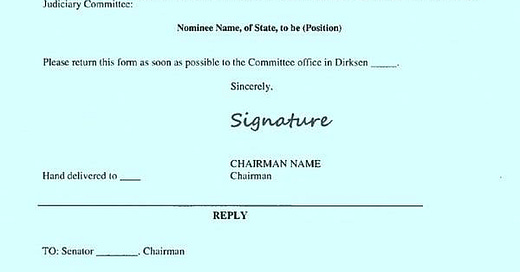The Case for Eliminating the Blue Slip: the Outdated Senate Tradition Keeping the Judiciary Empty
A Brief Historical Analysis of What Could Be the Senate's Most Harmful Unwritten Rule
Since 1917, the Senate Judiciary Committee has willingly left itself at the mercy of the blue slip, a tool used by individual Senators to prevent nominees from ever reaching the floor. The blue slip runs antiparallel to the purpose of government and allows for individual Senators to harm their constituents - but please their party - by leaving judgeships empty. Historically, blue slips have been used by white supremacists to delay and prevent enforcement of civil rights legislation. Now, Senators abuse the blue slip for political reasons, even though doing so makes the government less apt to serve the people. In order for the federal government to best serve the people, the blue slip should not exist.
When the President nominates an individual to fill a judicial vacancy, the Chairman of the Judiciary Committee gives both Senators from the nominee’s home state a blue sheet of paper; Senators are asked whether or not they approve of the nominee, with an optional section for comments/elaboration. Should both home-state Senators return favorable blue slips, the nominee will receive hearings and a committee vote. However, if one or both of the home-state Senators returns a blue slip disapproving of the nominee, or if they choose not to return the blue slip at all, the nominee traditionally does not receive formal proceedings. Their nomination is stalled, and their chances at serving the office they were nominated to are erased. When blue slips are used to prevent a nominee from moving forward, the President will often leave the nominee stuck in the endless politics of the Senate because they do not want to seem powerless or admit defeat. The continued existence of the blue slip process is the result of an informal agreement among Senators and parties to only advance their nominees.
With the removal of the filibuster for judicial nominees, the blue slip is now one of the only ways for the minority party to block the ruling party’s nominees. Blue slips are more than merely a tool of pure obstruction and greed: historically, the blue slip has been used by segregationist Senators to entrench structural racism. Brown v. Board of Education (1954) granted power to district judges to enforce the Supreme Court’s ruling. Senator James Eastland, a staunch and vocal segregationist and white supremacist, chaired the Judiciary Committee from 1957 through 1979; he mandated that both home Senators return positive blue slips in order for nominees to advance. Eastland used blue slips to empower segregationists, maintain judicial vacancies, slow the integration of schools, and entrench structural racism in America. When Sen. Strom Thurmond became the Chair of the Judiciary Committee, he chose to make exceptions to the rule only when it would benefit his party. In 1983, when a Reagan nominee received a negative blue slip, Thurmond proceeded with hearings anyway and the nominee was confirmed by the whole Senate. Slowly, though, as the judiciary became more politicized - exacerbated by the removal of the filibuster for judges - the blue slip turned into the only way for an individual senator to prevent a judgeship from being filled.
Blue slips are one of the most important reasons why the federal bench is so empty, and removing this tradition would allow judges across the country to be confirmed - and the federal bench to be filled. The vast majority of cases heard by federal judges are not political, and vacancies prevent cases that impact people from being heard. Court. By allowing appellate benches to remain empty until a nominee aligns with their political beliefs, a Senator can exert control far beyond that of their office. It is an unwritten rule that allows politicians to act in a manner never envisioned by the founders. Because it is an unwritten rule, its impact is extremely powerful, yet arbitrary - and there is no limit on how its power can be exercised.
The Chairman of the Judiciary Committee has the power to eliminate blue slips, but will never do so; they want to protect their party’s right to block qualified judicial nominees when they are in the minority. Since the blue slip is an unwritten rule never codified in law, it serves as both any single Senator’s most powerful tool and an outdated piece of Senate tradition. Keeping the blue slip intact only serves to harm everyday Americans: voters, constituents, and citizens. Removing the power of blue slips would enable the Senate to act in a manner that honors written rules, enforce the power of law, and promote a standard of action for all branches of government.
A Bibliography
“Black Caucus presses Senate Dems to blow up tradition on judges,” by Burgess Everett and Nicholas Wu (accessible on both Politico and Rep. Steven Horsford’s website)
“Good Riddance to ‘Blue Slips’,” David Lat. Cover picture is from here.
“The Senate Should Retire Blue Slips to Veto Judicial Nominations,” by Caleb Hayes-Deats




